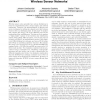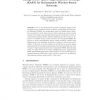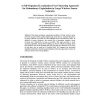714 search results - page 32 / 143 » Time and energy complexity of distributed computation in wir... |
CCS
2007
ACM
14 years 3 months ago
2007
ACM
Wireless sensor nodes generally face serious limitations in terms of computational power, energy supply, and network bandwidth. Therefore, the implementation of effective and sec...
WCNC
2010
IEEE
13 years 7 months ago
2010
IEEE
—Since sensor nodes use batteries as their source of energy, energy-based routing becomes an important requirement to extend network lifetime. This routing is done using the node...
EWSN
2010
Springer
14 years 3 months ago
2010
Springer
Due to non-homogeneous spread of sunlight, sensing nodes typically have non-uniform energy profiles in rechargeable Wireless Sensor Networks (WSNs). An energy-aware work load dist...
EUSFLAT
2007
13 years 10 months ago
2007
The embedded soft computing approach in wireless sensor networks is suggested. This approach means a combination of embedded fuzzy logic and neural networks models for information...
GI
2008
Springer
13 years 10 months ago
2008
Springer
: This paper investigates organization problems of large wireless sensor networks. In spite of their random deployment, nodes have to organize themselves as energy efficient as pos...



